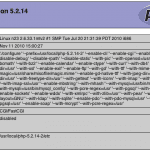Docker + Speedtest Tracker
I love that I have a Synology since I can run my own Speedtest Tracker! I was having issues on Zoom and knew it was me as I have notifications set up when my ping or up/download speed drops. You can run this on pretty much anything, a raspberry pi or a spare mac. Just install docker, and you’re off to the races!
Install Multiple PHP packages based on Version
Want to install a bunch of PHP packages easily via CLI for a different PHP version.? Just run the following snippet. It works in bash and zsh, and can be used with apt and yum 🙂
apt-get install php74-{mbstring,mysql}
Ubuntu apt Don’t install recommended software.
I required smartctl command from the smartmontools package under Ubuntu, and simply running apt-get install smartmontools resulted in some recommended packages to be installed suck as mail-utils and postfix of which I required neither.
There is an option with apt, which will not install recommended packages, its --no-install-recommends as you can see in the below example.
apt-get install --no-install-recommends smartmontools
